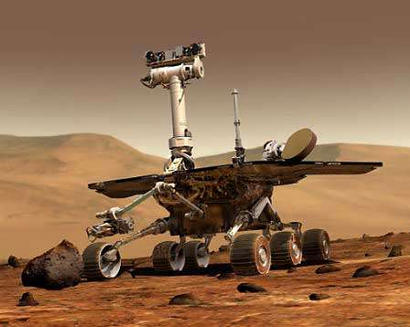Spirit, the robotic geologist to roam on Mars
( 2004-01-04 14:03) (Xinhua)
The exploration of Mars entered a new phase as Spirit, the first of US twin rovers, landed on the Red Planet on Sunday Beijing time.

The Mars Exploration Rover, Spirit, is shown in this undated artist's drawing released by NASA . [AP] |
The rover can work as a robotic field geologist and can see sharper images, explore farther and examine rocks better than anything that's ever landed on Mars, scientists at the US space agency NASA said.
Spirit, as big as a mini-car, is equipped with a suite of scientific instruments that will be used to read the geologic record at the landing site, to investigate what role water played there, and to determine how suitable the conditions would have been for life.
It has a panoramic camera at human-eye height, and a miniature thermal emission spectrometer with infrared vision that can help scientists identify the most interesting rocks.
The six-wheeled rover can watch for hazards and maneuver around them and has a deck of solar panels, about the size of a kitchen table, for power. It can drive to the selected rock and extends an arm with tools on the end.
A microscopic imager, like a geologist's hand lens, can give a close-up view of the rock's texture. Two spectrometers can identify the composition of the rock and the fourth tool, which substitutes for a geologist's hammer, can expose the fresh interior of a rock by scraping away the weathered surface layer.
Spirit will stop at Gusev Crater, a bowl bigger than the US state of Connecticut that appears to have held a lake long ago. Scientists will use the robot's instruments to seek and analyze geological evidence about past environmental conditions in the crater.
If sedimentary rocks lie on the surface, they may yield telltale clues to whether the crater ever did hold a wet environment that might have been suitable for sustaining life, scientists said.
|

